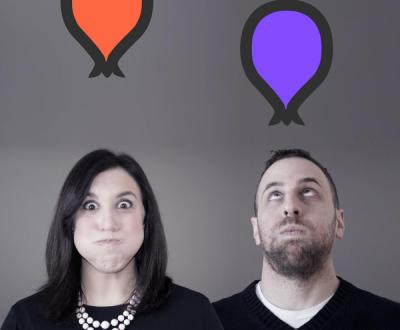Baloonr Helps Teams Get Ideas Off the Ground

Ask a roomful of kindergarteners if they're artists, and all of them will unanimously boom "YES!" Ask adults, though, and the story changes dramatically. Maybe one or two people assert their creativity, but everyone else looks awkwardly at the floor or each other. Somehow between kindergarten and adulthood, we lose the confidence that made us all feel like artists.
Noah Bornstein (CS'13) and co-founder Amanda Greenberg want to change all that through their start-up, Baloonr.
Founded in 2013, Baloonr is on a mission to unleash the hidden potential of every team in the world by providing a highly efficient, streamlined, fun way to gather information and ideas. More than that, Bornstein and Greenberg want everyone to feel creative again.
"We want to drive people back to when they were five and six years old and at their most creatively empowered," said Bornstein, a graduate of Carnegie Mellon's Master's in Human-Computer Interaction program. "They were free. They weren't as self-conscious. That's really what we're trying to do with Baloonr — to get people back to that 100 percent creative confidence. That’s necessary to really get the most and best stuff out of a group."
Baloonr restores that fearlessness by providing an app for teams, companies and organizations that follows well-studied best practices for successful ideation — resulting in a higher quality and quantity of information and ideas. It levels the playing field, ensuring that there are no barriers to entry and all voices are heard.
Here's how it works:
A company or organization subscribes to Baloonr, then begins a stream — a topic, prompt or question. The stream creator invites team members to walk through the platform's four stages for idea creation and development: Launch, Evolve, Pump and Explore. In the first stage, the participants launch "baloons" — ideas, information or creative content. Users anonymously launch as many baloons as they want. "You don't get distracted like in an in-person brainstorm when everyone goes off on tangents or you get interrupted," Bornstein said. "This is a way for people to get the most and best ideas out there."
After all baloons are launched, the group moves into Evolve, where the still-anonymous baloons are combined and opened to also-anonymous peer comment. This continued anonymity allows people to be open and fearless as they refine baloons. Voting begins during the Pump stage, when users can either pump a baloon (i.e., vote for it) or not. To prevent bias, each baloon's creator is still a mystery and there's no way to see how many pumps a baloon has received. It's not until the big reveal in the Explore stage that users can see which baloons have received the most pumps and who created them (if the baloon creator chooses to reveal their identity). Data can also be exported for use in company communications and presentations.
Baloonr grew out of Bornstein and Greenberg's frustrations with teamwork in their pre-Baloonr careers, when they noticed that too frequently the best ideas weren't heard, acted on or even shared. “Key pieces of information are lost, and there wasn’t an efficient way to get information across diverse teams and positions,” Greenberg said. But Baloonr's success thus far as a tech start-up has a lot to do with CMU's Project Olympus, part of the university’s Center for Innovation and Entrepreneurship.
An initiative of the School of Computer Science, Olympus supports and accelerates the process of moving cutting-edge research and great ideas to the development and business stages. The program's centerpiece is its Problem-Oriented Business Explorations (PROBES), which allow faculty and students to investigate the commercial potential of their ideas.
Bornstein and Greenberg had developed the Baloonr concept and were exploring its value when Bornstein heard about Olympus in an entrepreneurship course. After talking with Kit Needham, Olympus' associate director and entrepreneur-in-residence, he and Greenberg realized that this was the university's best resource for them, and they soon became a PROBE project.
"When we pitch the company, we still say that Baloonr started with Project Olympus," Bornstein said.
"I started Project Olympus to provide resources and opportunities for our students to explore their start-up ideas — and to make important connections with the wider business and entrepreneurial communities —while they were still in school," said Lenore Blum, founding director of Project Olympus and Distinguished Career Professor of Computer Science. "It's tremendously exciting to see Olympus PROBEs like Baloonr hit the ground running when the founders graduate. "
While Olympus was vital to Baloonr's birth, Bornstein's time in the MHCI program and its emphasis on storytelling and user experience was vital to its evolution. "The MHCI program gave me a whole new perspective on products and how to design them," he said. "It's our goal that people feel an emotion when they use Baloonr … it should be fun and lightweight and delightful. And really, that stemmed in part from the MHCI program and its user-experience culture."
Baloonr continues to grow, with customers such as Procter & Gamble, Johnson & Johnson, Disney/ABC and the Children’s Hospital of Philadelphia on board or set to join soon. The team graduated from one of the top 10 tech accelerators in the nation, Philadelphia's DreamIt Ventures Accelerator, this past December, and Bornstein and Greenberg are currently raising their seed round funding. In the meantime, they're keeping their goals as lofty as "baloons."
"We are building a global raging empire of creative empowerment," Bornstein said. "We want to break down that wall to innovation by creating a true idea meritocracy — in teams, in companies and beyond."

